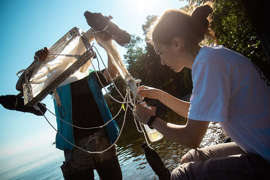
Irkutsk State University took samples of phyto- and zooplankton from a lake near Baikalsk, where a pulp and paper mill worked until 2013. Scientists from the Institute of Biology at Irkutsk State University will study them in the laboratory, and then compare them with observation data in this place over the past years, as well as with data taken from Baikal near the village of Bolshiye Koty, where the anthropogenic impact is noticeably less. The results will become known in the near future, and it will be clear from them what the state of the water area is and what measures need to be taken to prevent pollution.

– Regular sampling of phyto- and zooplankton is necessary to understand the mechanisms of functioning of the lake ecosystem. They give us an idea of changes, and therefore, can help predict them at other levels, – said Dmitry Karnaukhov, head of one of the groups of biologists at ISU.
In addition, in the Baikalsk region, for the first time, scientists took water samples to check for the presence of microplastics. This new type of pollution has not yet been sufficiently studied, so it is important to understand where hazardous particles can enter the lake and how they affect living organisms.
Note that samples at station No. 1, located in the south of Lake Baikal opposite the village of Bolshiye Koty, are taken every week within the framework of the Point No. 1 project. This is a unique scientific program of long-term eco-monitoring, which has been going on since 1945 and is included in the Russian Book of Records.
Observation of the water area of the lake near Baikalsk is carried out within the framework of an agreement between ISU and En + Group, as well as a project to create an International Center for Water Resources in the city. The current sampling expedition is one of the first steps to develop environmental monitoring near Baikalsk.

